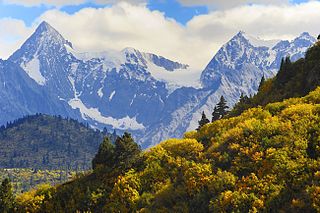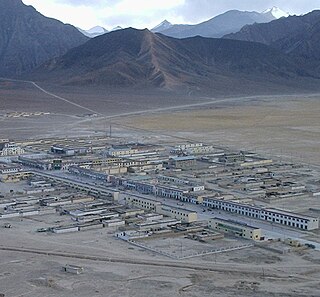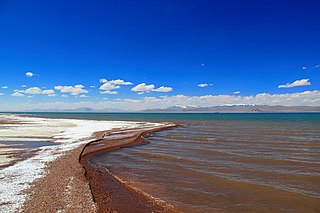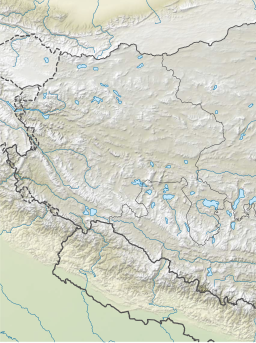
Lake Mansarovar, also called Mapam Yutso locally, is a high altitude freshwater lake fed by the Kailash Glaciers near Mount Kailash in Burang County, Ngari Prefecture, Tibet Autonomous Region, China. The lake along with Mount Kailash to its north are sacred sites in four religions: Hinduism, Jainism, Buddhism and Bön.

Tsetang or Zedang, is the fourth largest city in Tibet and is located in the Yarlung Valley, 183 km (114 mi) southeast of Lhasa in Nedong District of the Shannan Prefecture in the Tibet region of China. It is the capital of Shannan Prefecture.

Mount Nyenchen Tanglha is the highest peak of Nyenchen Tanglha Mountains, which together with the Gangdise range forms the Transhimalaya.

Pasho County or Baxoi County is a county under the administration of Chamdo Prefecture in the Tibet Autonomous Region. The county seat is at Pema, which is also called the Pasho Town. The county population is 35,273 (1999). It contains the Pomda Monastery and Rakwa Tso lake.

Pome County or Bomê County is a county of Nyingchi Prefecture in the south-east of the Tibet Autonomous Region. Historically known as Powo or Poyul, it was the seat of a quasi-independent kingdom until the early 20th century when troops of the Dalai Lama's Lhasa government integrated it into the central Tibetan realm. The population was 25,897 in 2004.

Dragsum Tsho (Tibetan: བྲག་གསུམ་མཚོ་, Wylie: brag gsum mtsho, THL: Draksum Tso, Pagsum Co, literally meaning “three rocks” in Tibetan, is a lake covering 28 square kilometres in Gongbo'gyamda County, Nyingchi of the Tibet Autonomous Region, China, approximately 300 km east of Lhasa. At 3,700 metres over sea level it is about 18 km long and has an average width of approximately 1.5 km. The deepest point of the green lake measures 120 metres. The lake is also known as Gongga Lake.
Dzongka or Zongga is a town and the administrative headquarters of Gyirong County in the southwestern Tibet region of China bordering Nepal. Being the administrative headquarters, it is also sometimes referred to as "Gyirong Dzong" or "Gyirong Town", but it is different from the original Kyirong Town in the southern part of the county.

Tsona County or Cona County is a county in Shannan prefecture in southern part of Tibet region of China. The county lies immediately to the north of the McMahon Line agreed as the mutual border between British India and Tibet in 1914. China has not accepted the 1914 border delineation, but treats it as the Line of Actual Control (LAC). The Tsona County also borders Bhutan on its southwest.

Drongpa County or Zhongba County (Tibetan: འབྲོང་པ་རྫོང་, Wylie: `brong pa rdzong, THL: drong pa dzong, ZYPY: Zhongba Zong; Chinese: 仲巴县; pinyin: Zhōngbā Xiàn; lit. 'Place of Wild Yaks') is a county of Shigatse Prefecture in China's Tibet Autonomous Region. Located in the western part of Central Tibet, it is the birthplace of the Tsangpo River (Brahmaputra). The county seat is at Labrang, which is also called the Drongpa Town.

The Nyang River is a major river in south-west Tibet and the second largest tributary of the Yarlung Tsangpo River by discharge.

Purang or Burang, known as Puhreng in Tibetan, is a town which serves as the administrative center of Purang County, Ngari Prefecture of the Tibet Autonomous Region (TAR), China. The town lies at an altitude of 3,900m in the valley of the Karnali River. The town spans an area of 3,257.81 square kilometres (1,257.85 sq mi), and has a permanent population 6,047 as of 2010, and a hukou population of 4,477 as of 2018. To the south are Gurla Mandhata and the Abi Gamin ranges. Lake Manasarovar and Mount Kailash are to the north. This region is the mythological and actual river nexus of the Himalaya with sources of the Indus, Ganges and Yarlung Tsangpo/Brahmaputra all within 110 kilometres (70 mi) of Purang.

The Rutog Town , called Rituzhen in Chinese, is a town and the seat of Rutog County in the far western Tibet Autonomous Region. It is also a major military base for China near the disputed border with India allowing it to press its claims militarily.
Sengli Co or Senlicuo or Sengli Tso is a freshwater alpine lake of Zhongba County, Shigatse in Southern Tibet, China.
Spanggur Tso, also called Maindong Tso, Mendong Tso, is a saltwater lake in Rutog County in the Tibet Autonomous Region of China, close to the border with Ladakh. India claims a major portion of the lake as its own territory, as part of Ladakh. To the west of the lake lies the Spanggur Gap, a low pass through which the Line of Actual Control runs. To the north is the much larger lake Pangong Tso. Spanggur Tso is at an elevation of 4305 meters, and has an area of 61.6 square kilometres. The lake's average annual temperature is around -4 to -2 ℃, and the annual precipitation is 50 to 75 mm. The western portion of the lake is claimed by India.
The Angsi Glacier or Nangser Glacier is a glacier located on the northern side of the Himalayas in the Purang County in China's Tibet Autonomous Region. It is immediately to the east of the Indus-Tsangpo water divide at the eastern edge of the Purang County. One of the headwaters of the Tsangpo River (Brahmaputra), called Angsi Chu or Nangser Chu, originates in this glacier. Angsi Chu merges with the Chema-yungdung Chu within a short distance, and the combined river is called Chema-yungdung Chu.
Kyirong or Gyirong , Jilong in Chinese and Kerung in Nepalese, is a town situated in the southern part of Gyirong County in the Tibet Autonomous Region, China. The town is situated on the east bank of Kyirong Tsangpo, a source stream of the Trishuli River, at an elevation of about 2,700 metres (8,900 ft). It has a subtropical mountain monsoon climate, with reasonable precipitation and warm weather, unusual for Tibet.
Nyamjang Chu, or Nyashang Chu (Tibetan: ཉ་བཤང་ཆུ, Wylie: nya bshang chu, THL: nya shang chu) is a cross-border perennial river that originates in the Shannan Prefecture of Tibet and flows into the Arunachal Pradesh state of India, joining the Tawang Chu river just before it enters Bhutan. The Nyamjang Chu valley has provided the traditional communication route between Tawang and Tibet. The valley near town of Zemithang in the Tawang district, called the Pangchen Valley, is known for its serene beauty and forms one of the wintering locations for the black-necked crane.

Dazecuo is one of many inland lakes in Tibet. It is a salt lake on the Tibetan Plateau in Xainza County within Nagqu in the Tibet Autonomous Region of China. It was reported in 2021 that the lake receives "good environmental protection".

Dochen Tso or Duoqing Cuo is a high-altitude lake in Yadong County in the Tibet region of China.

Darebu Cuo or Darab Co or Tarap Tso or Darebu Lake is a high-altitude alpine lake in Tibet, China.















